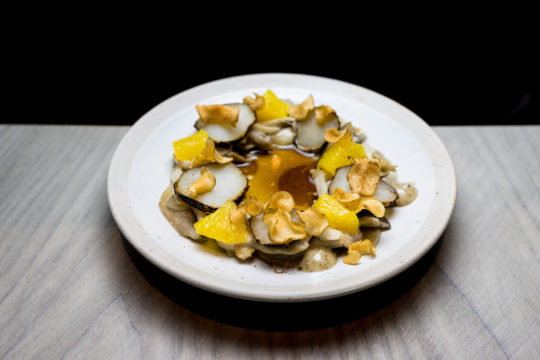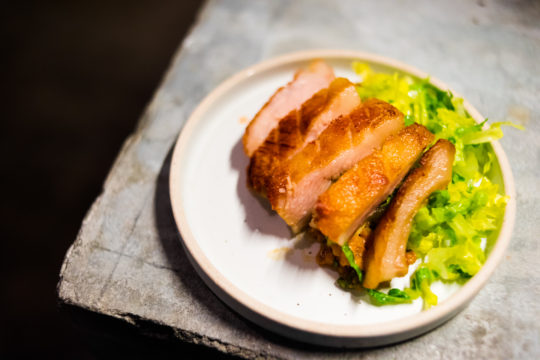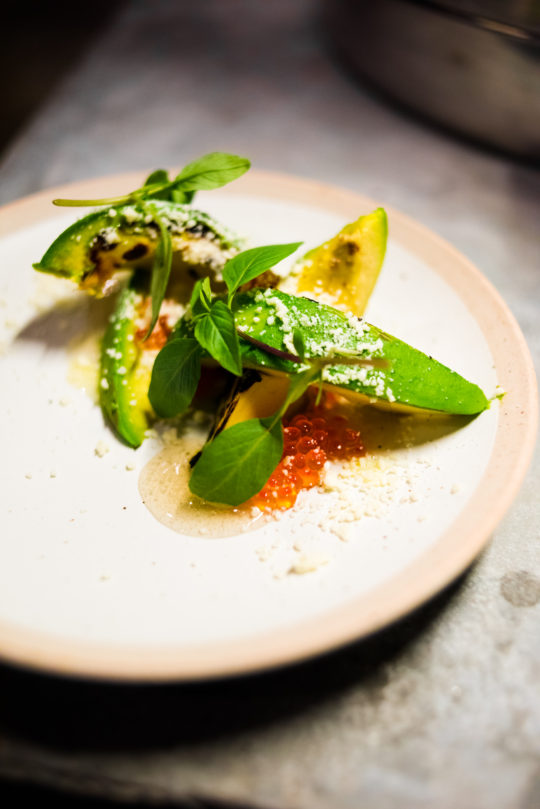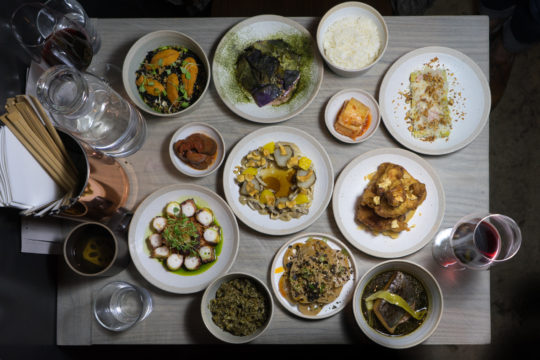Before coming to the US – JP worked in some of the world’s best restaurants, including The Ledbury in London and Cutler & Co. in Melbourne, Australia, He was the Chef de Cuisine at Jungsik Dang in Seoul, South Korea before joining 2 Michelin starred Jungsik restaurant in New York. In the summer of 2016, together with his wife Ellia, they opened Atoboy, a modern Korean restaurant with a unique banchan-style tasting menu.
Tell us a bit about where you grew up and how you got interested in food.
Though I was born in Gumi – a city about 4 hours drive south of Seoul – I call Seoul my home as I’ve lived there since I was four. I was fortunate to always have great home-cooked meals growing up as my mother was a great cook, but since both of my parents worked full-time I was often left with the responsibility of feeding myself and my older brother. Sometimes that meant re-heating the banchans or soups that my mother had prepared ahead of time, and other times it meant me being creative with whatever was in the pantry and whipping up a meal on my own.
Becoming familiar in my family’s kitchen, my interest in food intensified in a bit of a silly way also. There is a very famous Japanese comic book called Shota No Sushi or translated in Korean “Mr. Sushi King.” I got very into it, and for a good amount of time I really wanted to learn the art of sushi to become a sushi chef.
The bits and pieces of curiosity I gathered growing up led me to enroll in KyungHee University, which was well-known for its culinary and hospitality management programs. While in school, my desire to polish my skills abroad blossomed as I learned more about the culinary movements by becoming familiar with legendary chefs with books such as The French Laundry Cookbook. With this in mind, I decided that my goal would be to transfer into C.I.A. in Hyde Park to graduate so I was also busy studying English.
Towards the end of my university days, I got accepted to an exchange student program for restaurant management in Finland. This is when I really got a chance to immerse myself in the culture and the cuisine firsthand, and after the exchange student program I decided to go over to London to further my externship as I was fortunately six-months ahead of schedule for my graduation track.
How did you start cooking professionally?
In London, I had a chance to work at The Ledbury under Chef Brett Graham who is originally from Australia. He became somewhat of a mentor for me and through him I was able to build connections to Melbourne. After the London chapter, I then decided to pursue my career further with Chef Andrew McConnell in Melbourne, Australia. I worked with him through his transitions to and from multiple properties from 3,1,2 , Cumulus Inc., and also Cutler & Co.
What is your food philosophy?
To cook delicious food, using balance as a main concept, whether it’s a balance in flavor, texture, color, cultural roots, new and old. Furthering my pseudo-philosophy on balance, my favorite balance when it comes to food is the rising relevance and popularity of seasonality and local ingredients combined with the predominance of fermented, preserved, and dried ingredients which I am used to while growing up in Korea.
Korean Food is just recently gaining a wider understanding and appreciation in the US. Why do you think it took so long?
I think it largely has to do with the change in society, especially the immigrant culture. I’m sure most of the Korean restaurants a few decades back opened to cater to the expats who may long for taste of home. Though there certainly is a need for that reason, it also keeps the food and the cuisine within limits. Nowadays as well as in the most recent years, many Korean restaurants are opened by second generation immigrants with the mission to not only please the palates of those seeking traditional Korean flavors but also to spread the word to the non-Koreans.
Moreover, there is also the inevitable rise in social media and its impact. Now, it’s only a matter of a few seconds for someone to see what Korean food looks or tastes like through the scrolls on Instagram or a quick read on Yelp. And I also can’t fail to mention the interest in the Korean culture overall from K-Pop, K-Beauty, and more. But at the end of the day, Korean food is just soul-satisfyingly delicious and unbelievably well-balanced. I think it would’ve been just a matter of time until everyone jumped on the bandwagon of eating it.
Is there something that gets lost in translation for Korean cuisine coming abroad? I know you worked in both Australia and London before coming to NY? Is there something or an essence about the cuisine that is not able to be replicated outside of Korea?
I think it’s the same with other ethnic cuisines like Thai, Japanese, and more. You hear people say all the time that the best sushi they’ve ever had was in Tokyo, or the best pho was enjoyed in Saigon. It’s just nearly impossible to replicate flavors that has so much to do with not only the seasonings and ingredients but also the atmosphere, climate, culture, and more.
But my job as a chef is to restlessly study, research, and test to put my best foot forward in hoping that the diners can experience that sense of nostalgia and excitement. In order to do this successfully, most often chefs would embrace the locale in which they are in and apply their techniques and memories to create these dishes. With that said, I think the most authentic experiences are best left in the places of origin.
For us, we try to embrace New York whether it’s the climate, the palette, ingredients, and techniques. If Atoboy were to be also opened in say, Paris or Seoul, I’m sure it would take on an entirely different flavor profile.
Can you explain the meaning of Atoboy and how did the concept develop?
“Ato,” in old Korean means gift. So we wanted to create a restaurant that can continuously bear gifts for our guests, whether that comes through our food or hospitality. In creating the vision, we wanted to expand on the well-known and loved concept of pairing all things with a bowl of rice as you would when you eat a properly prepared Korean meal. That as a canvas, we also wanted to put banchans in their own spotlight by applying extra care and attention as well as modern techniques and unlikely touches and flavor combinations that is very much NYC.
Your background in Seoul and working at Jungsik here – is quite fine dining. Can tell us a little about what fine dining means for Korean cuisine?
Similar to the significance it bears here in the US, fine dining in Korea is always mostly reserved for very special occasions or for extremely special guests one would host. The origin was many Korean fine dining restaurants and its culture I can say perhaps is from the traditional Korean meals called “Han Jung Sik” where the variety and colorful banchan dishes grace the table with a perfectly cooked rice, a seasonal soup or stew and a meat, poultry, or fish dish of some sort. A great Han Jung Sik experience also must be accompanied by great sense of hospitality, which in Korean form is delivered with impeccable precision and grace.
What is a specific ingredient you are excited about right now?
Fresh bamboo shoots!
I heard you recently moved across the street from the restaurant, and I know you both love dining out. Do you ever cook at home and if so what?
If we do get a chance to be home for dinner (which is already rare), we try to dine out. It’s hard to have a well-stocked refrigerator or pantry since we practically live at the restaurant, but we also like to support our industry friends by stopping by when we can to enjoy their restaurants and say hello.
Before Atoboy opened, we liked to cook often—I’d make a lot pasta dishes, or foods that are far from the Korean flavor profiles since I am immersed in it otherwise.
Favorite places to eat in New York (or elsewhere)?
That’s a hard question since there are so many great places in New York, but Ellia and I really enjoy Estela and Wildair….and also I cannot forget Atoboy! Though I have yet to formally dine here myself.
In Seoul, there has been a really amazing rise in the modern Korean cuisine movement, so I would highly recommend destinations such as Mingles, Zero Complex, and also TocToc. This change in Seoul’s dining scene makes me really proud as a Korean chef on a mission to spread word about the depth of Korean cuisine and its deliciousness.





